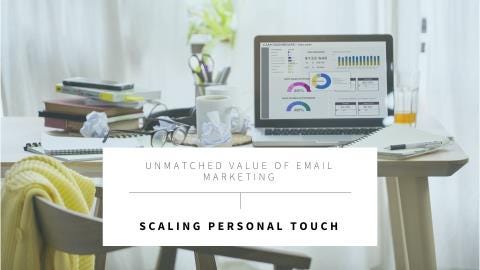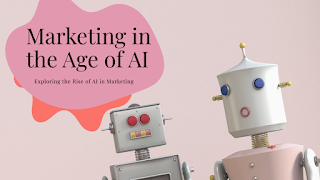Scaling Personal Touch: The Unmatched Value of Email Marketing (The Unique Power of Email)

Email marketing stands out among digital marketing channels for its unique ability to deliver personalized, meaningful interactions at scale. Unlike social media posts or pay-per-click ads, emails can be tailored to the individual recipient, creating a sense of personal connection that drives engagement and loyalty.
Are you leveraging the full potential of email marketing to create personalized, valuable customer experiences? Discover how email can transform your marketing strategy and deliver unparalleled results.
Why Personalization Matters
Building Relationships at Scale

Personalized emails create a direct line of communication between your brand and your audience. According to a study by Experian, personalized emails deliver 6x higher transaction rates. This is because recipients feel valued when they receive content that speaks directly to their needs and interests.
Example: Amazon uses personalized email marketing to recommend products based on customers’ previous purchases and browsing history. This strategy not only enhances the customer experience but also drives significant sales, contributing to Amazon’s impressive revenue growth.
Increased Engagement and Conversion Rates
Emails with personalized subject lines are 26% more likely to be opened, as per Campaign Monitor. Moreover, segmented and targeted emails generate 58% of all revenue, showcasing the importance of delivering relevant content to the right audience.
Example: Spotify sends personalized emails featuring users’ most-listened-to songs and artists, along with recommendations for new music. This tailored approach keeps users engaged and encourages them to spend more time on the platform.
Enhanced Customer Loyalty
When customers receive personalized content, they are more likely to feel connected to the brand, leading to increased loyalty and repeat business. Epsilon found that 80% of consumers are more likely to make a purchase when brands offer personalized experiences.
Example: Starbucks uses personalized email campaigns to inform customers about their rewards status, special offers, and personalized drink recommendations, fostering a sense of loyalty and encouraging frequent visits.
The Mechanics of Personalized Email Marketing
Data Collection and Segmentation

To create personalized emails, you first need to collect data about your customers. This includes demographic information, purchase history, browsing behavior, and engagement with previous emails. Tools like HubSpot and Mailchimp offer advanced segmentation capabilities, allowing you to categorize your audience based on various criteria.
Example: Sephora collects data on customers’ past purchases and preferences to send targeted emails with product recommendations, beauty tips, and exclusive offers, driving higher engagement and sales.
Crafting Personalized Content
Once you have segmented your audience, the next step is to create content that resonates with each group. This involves personalizing subject lines, email copy, and calls-to-action based on the recipient’s interests and behaviors.
Example: Netflix sends personalized emails recommending TV shows and movies based on users’ viewing history. This personalized approach helps retain subscribers and encourages them to explore more content on the platform.
Automation and Scalability
Email marketing automation tools like ActiveCampaign and Sendinblue enable you to scale your personalized email efforts. Automation allows you to send the right message to the right person at the right time, without manual intervention.
Example: Uber uses automated email workflows to send personalized ride recommendations and offers based on users’ travel patterns and preferences, enhancing the user experience and encouraging repeat usage.
Advanced Strategies for Personalization
Dynamic Content

Dynamic content allows you to customize different parts of your email for different segments of your audience. This can include personalized product recommendations, customized greetings, and tailored offers.
Example: Booking.com uses dynamic content to show personalized hotel recommendations based on users’ previous searches and bookings, making the emails highly relevant and increasing the likelihood of bookings.
Behavioral Triggers
Behavioral triggers are automated emails sent based on a user’s actions or behaviors. This includes welcome emails, abandoned cart reminders, and post-purchase follow-ups.
Example: Etsy sends abandoned cart emails with images of the items left behind, along with personalized recommendations and special offers to encourage users to complete their purchase.
A/B Testing
A/B testing allows you to test different elements of your emails to see what resonates best with your audience. This includes subject lines, email copy, images, and calls-to-action.
Example: BuzzFeed uses A/B testing to optimize their email newsletters. By testing different subject lines and content formats, they have been able to increase open rates and engagement.
Practical Applications for Marketers
Marketing Managers
Marketing managers can leverage personalized email campaigns to nurture leads through the sales funnel. By sending targeted content and offers based on the recipient’s stage in the buyer’s journey, managers can improve lead conversion rates.
Example: A marketing manager at HubSpot might send personalized emails to prospects based on their interactions with the company’s website and content, offering tailored resources and consultations to move them closer to a purchase decision.
Content Creators
Content creators can use personalized email campaigns to distribute their content more effectively. By segmenting the audience and tailoring the email content to match their interests, creators can drive higher engagement and content consumption.
Example: A content creator at BuzzFeed might send personalized email newsletters featuring articles, quizzes, and videos based on the recipient’s past interactions with the site, increasing click-through rates and user engagement.
Sales Teams
Sales teams can benefit from personalized email campaigns by sending targeted follow-ups and offers to prospects. By personalizing the content based on the recipient’s previous interactions and pain points, sales teams can improve their chances of closing deals.
Example: A sales representative at Salesforce might send personalized emails to prospects who have shown interest in specific features, offering tailored demos and case studies to address their unique needs and challenges.
Final Thoughts: Embrace the Power of Personalization
Personalized email marketing is a powerful tool that can help you build stronger relationships with your audience, drive higher engagement and conversions, and enhance customer loyalty. By leveraging data, crafting personalized content, and using automation, you can scale your efforts and achieve remarkable results.
Don’t miss out on the incredible potential of personalized email marketing. Start creating valuable, personal touches at scale today and watch your brand’s growth soar!
Conclusion: Ready to Transform Your Email Marketing?
With the insights and practical tips provided in this blog, you’re now equipped to harness the power of personalized email marketing. Start collecting data, segmenting your audience, and crafting personalized content to deliver exceptional customer experiences and drive your brand’s growth.
Join the discussion and share your thoughts

Comments
Post a Comment